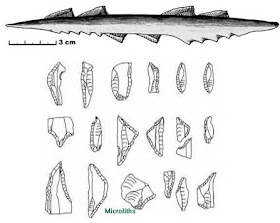Common Tools
 |
| Barbed and Tang Arrow Head |
 |
| Hand Axe |
Hand Axe – axes vary considerably between periods from earlier Palaeolithic flaked axes to later Neolithic polished axes. Uses include tree/wood cutting, butchery and digging.
 |
| Knife |
 |
| Scraper |
 |
| Awl |
Awl – flint flake worked into a point at one end and used to pierce holes into material e.g. animal hide to make items of clothing.
 |
| Blade |
 |
| Microlith |
Microliths – a common find from the Mesolithic period. These small blades have a multi-functional use and were often imbedded into different wooden or bone tools to make harpoons and sickles.
Amesbury Archer
The Amesbury Archer’s Bronze Age grave has an excellent example of a prehistoric hunting tool kit. The Amesbury Archer was aged 35-45 years old and originated from the European alpine region. He was buried in the Beaker burial tradition, near Stonehenge. This was an unusual grave with around 100 grave goods which indicate the man’s occupation as a hunter and a metal smith.
Hunting tool kit;
-16 Barbed and tang arrowheads.
-2 blank, ready to finish arrow head.
-2 Sandstone wrist guards, to protect the man’s wrist while using a bow.
-Flint knapping debris.
-Flint scrappers, used for skinning animals.
-Flint knife, used for butchery.
-Fire lighting kit.
-Boars tusks; a prestige item kept by those hunters skilled enough to hunt a wild boar and possible sharpened for use as awls to pierce leather.
-Red deer antler possibly used for flintknapping to finely retouch tools.
In addition to the above hunting kit other flint knapping tools would often feature in a prehistoric hunter’s kit such as a hammerstone, core and flakes. These would have been used to replace or reshape tools which are broken during hunting.

No comments:
Post a Comment